Where are we? Where shall we go? Which direction are we heading in now? We don’t know. We just keep on walking forward, faster and faster…
Do you get puzzled when urgent work suddenly comes between daily tasks? Did you ever feel anxious seeing the bulk of pending tasks and files at your tables? In today’s fast-paced world, no matter how organized a person is, it can cause severe troubles in your professional and personal life if you cannot control stress smartly.
Looking forward makes no sense in this case. Instead, we need to trace back, “listening” to the “Echo From The Ancient”.
context and significance
Background
As mentioned above, we are in thrall to a fast-paced era and confronted with the tremendous pressure and anxiety generated by this era, people badly need a space to rest and breathe. In today’s fast-paced world, our project creates a space of meditation.
Inspiration
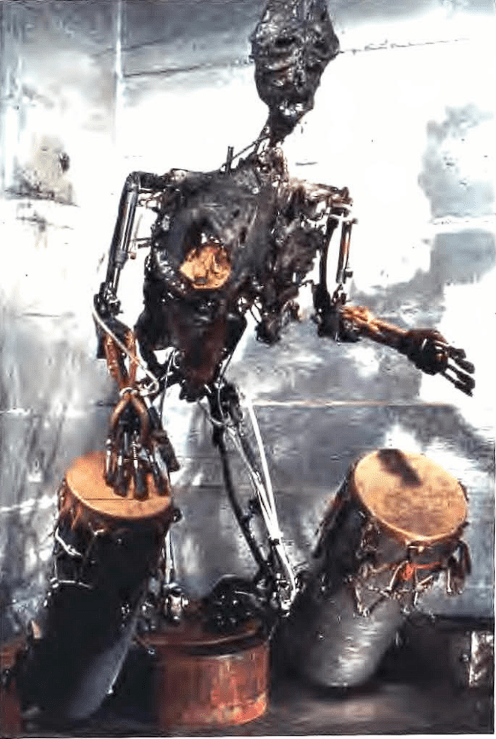
In the inspiration-collection stage, both me and teammate Livvy were impressed by a project called “The Drumming and Drawing Subhuman,” created by Chica MacMurrie in 2000. The computer-controlled robot is capable of performing drum plays by moving its ‘hands’ in a style similar to human drummers but in a struggling way to achieve these “easily-achieved motions”. When I first looked at this piece of artwork, its exaggerated, impaired appearance instantly grabbed my attention. Such an artwork has profound meaning in the “reflection stage” and participants’ “reevaluation” and “rethink” since it sheds lights not only on the struggling plight of those disabled but a hierarchical human society.
Thus, our main takeaways from this project are, first, our project needs an impressive appearance to attract the audience, making it easier to elicit their emotional change or reflection; second, using some movements by machine or visible, perceivable alter may be more effective in evoking the audiences’ emotional change or reflection.
And since both of us are intrigued by ancient Chinese culture, we chose to use an ancient Chinese painting “Thousand Li of Rivers and Mountains” as the proto of our project, aiming to make a combination of this painting and mechanic movements, creating a space for people to take a breath and reflect on their fast-paced lives.
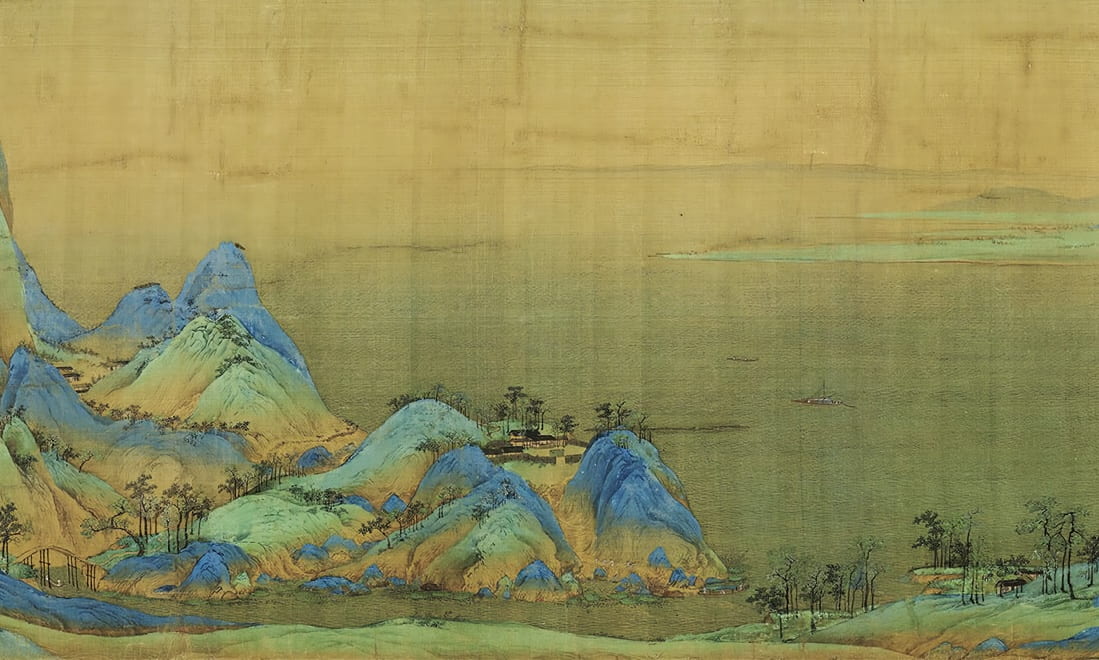
Then, we came to our own definition of interaction, which is the exchange and tackling of information and signals sent from different, multiple actors, happening spontaneously and giving actors enough autonomy to elicit their evaluation or reflection on the information exchange that just happened in order to achieve the designer’s purpose. So, basically, since there are solely two actors—our project and one audience at a time, the audience will interact, acquiring information from our project without evident guidance, just with some hints, so the information exchange process is almost spontaneously happening at the time. Then, from the information sent by our project, especially the movements of water flowing and boat rowing, with the beauty of our mother nature as the main background and layout, the audience receives a signal of relaxation and a return to nature. Such information about the ‘low’ movement of nature can form a huge contrast with our ‘fast-paced’ life, evoking the audience’s reflection of the current life and exploring other meanings of life so as to achieve our purpose—let the audiences reflect on their lives inspired by the ‘alive painting of nature and low life style”.
SIGNIFICANCE
Above all, our targeted audiences are the vast majority who get involved in today’s fast-paced world and potentially need to take a rest from it.
Bringing “Thousand Li of Rivers and Mountains” to life by using interactive elements, on one hand, since most people nowadays are looking more into the future and prospects of humans and less focused on human traditional cultures, with one piece of evidence that “The trend mirrors a global one; four-fifths of countries in the Organization for Economic Coöperation reported falling humanities enrollments in the past decade” (Heller 4), we seek to create a path to the past, where participants can experience the beauty of serenity that has resonated through centuries of Chinese history. On the other hand, the interactive elements that mimic the dynamic essence of nature and the changing scenes depicted in the painting help to foster a connection with the past. We want to offer an escape from the busy modern life, inviting participants to find a sense of inner peace by showing them Ximeng Wang’s, who is the creator of the painting, “expressing the image of the peaceful world: the distribution of mountains and forests reflects the order between an emperor and courtiers, gentlemen and snobs; the mountain landscape is endless and steep, but it does not show the pass of the city defense but emphasizes the leisurely elegance of the scholars and the livelihood of the people; the clear water and the blue waves are not only the performance of the season but also the symbol of peace”(Ma 65).
Moreover, the interactive design goes beyond the original painting, which strives to utilize the painting skills and techniques to show the dynamic charm of nature and people via static scenes in the depiction. But our interactive design endows the painting with live features, making it alive. By engaging in the interaction and immersing themselves in our interactive painting, participants can not only appreciate the unprecedented, quaint masterpiece, but get an authentic insight into the real, alive,and dynamic paintings through interactive components. Hence, they can immerse themselves in this low-lifestyle painting and reflect on their status quo lives, exploring other possibilities of lifestyles or just enjoying a moment of relaxation.
conception and design
Based on our design, our users will experience one-to-one interaction with our project. We decided on several interactive designs:
*We are going to first make the warranted components of the project, including “the house,” the river, and the boat, with cardboard, fabrics, and printed surfaces.
*Potentiometer serves as the LED controller, adjusting the brightness of LED lights to simulate environmental changes in scenes, such as day-to-night transitions in landscape paintings.
The potentiometer will be inserted into the cardboard, camouflaging its silhouette with pieces of the painting printed. For the LEDs, they could be hidden in the “house” and the new components we make.
*Magnet switch serves as triggering animations to simulate flowing water and boat rowing. We will decorate it with printed traditional Chinese expressions of “winds”, so that as participants approach, they can clearly distinguish the switch and automatically match them together, and the scene comes to life: the water begins to flow (if everything goes well with our design).
*Servo motors hanging with some threads can generate the gentle movement of the water flow by dragging the fabrics. Servo motors will be attached to the back of the cardboard. *The steppermotor serves as the engine of the boat. The boat’s rowing movement can be realized by its rotation.
Our criteria basically lie in accessibility and the difficulty of installing them and making them move. For instance, the most solid and sufficient material we can get access to is cardboard. Thus, we used cardboard to make the boat, its rotating rod, the basic layout, and the little house. Also, it is easy to install and assemble, just glue works. Moreover, they are really easy to shape and severe, saving our strength in assembling and constructing them. Then, based on this principle, we also borrowed some wood sticks and bought some fabrics for the same reason, to mimic the water flow. As we wanted to mimic the water flow, we had to find some materials that were flexible and when they were dragged, it was really obvious. The mix of blue and golden fabrics meets all these criteria. We have thought about using cloth as the material for water. However, they are too thick and too distinct from the original layout, so we quit this idea. For the motors, the reason why we chose servo motors and the steppermotor is that their rotating speed and angle can be effortlessly controlled and adjusted by Arduino code, which is really convenient, while the movement made by them is also obvious for the audience to perceive. As for the lights, we first wanted to choose LED for both the sun and the lights in the little house. However, when we tested them, we found that the LED’s light was too dim to attract the audience’s attention. So, we swapped it to KEYES 3W LED Module High-Power with PCB Chassis for Arduino STM3, which is much brighter than LED.
Fabrication and production
In this section, I will describe and assess the most significant steps in our production process, both in terms of failures and successes.
Preparation
In the initial stage, Livvy and I both coordinated two in-person conferences to discuss the topic we were both interested in and the form of our project that we expected. We came to a consensus that both of us are interested in traditional Chinese culture. And both of us began to search online for inspiration. Livvy then found the famous Chinese painting “Thousand Li of Rivers and Mountains”, showcasing the breathtaking beauty of nature. She came up with the idea that we could use it to contrast the fast-paced lifestyle nowadays with the shown low lifestyle in the painting. I totally agreed, so our theme was decided.
After deciding on our theme, we started to write the proposal. I took on the main part of writing the background and significance of our project, and Livvy was responsible for drawing the sketch. We cooperated to settle down the elements or component parts. And then we discussed our tasks and cooperation. Since Livvy is more good at coding, she took on the coding and assembly tasks. I just wrote the controlling LED to be a bright-to-dim part and checked the code when there was something wrong. For me, I focused more on handmade tasks.
Then, we bought all the materials we needed, including the fabrics and glue, and printed the ancient painting out as our layout.
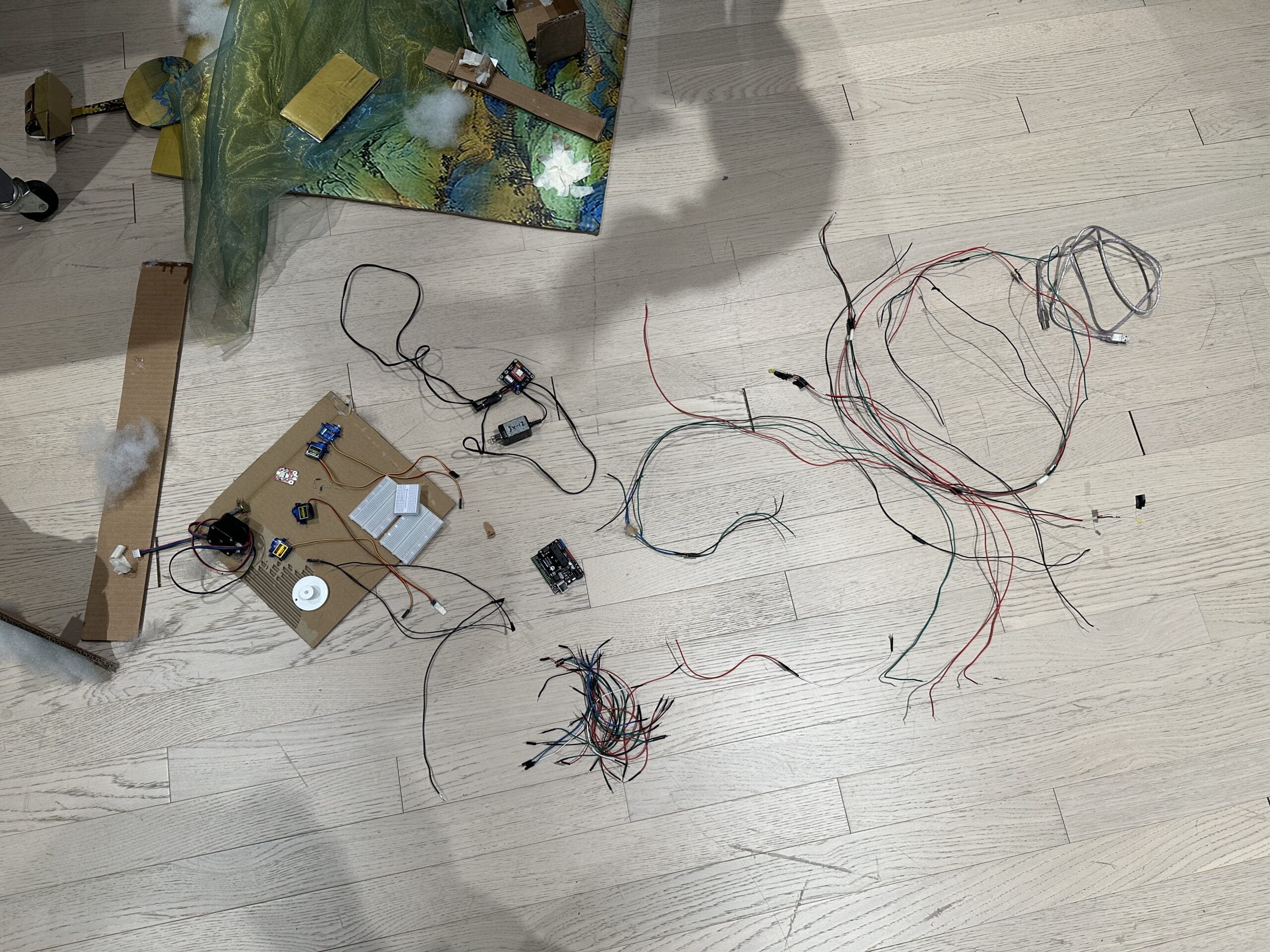


Constructing and Assembling
Step1:
To create our project’s basis and major layout, I cut out the cupboard, pasted the printed painting on it, and then severed it in line with the mountain’s silhouette.
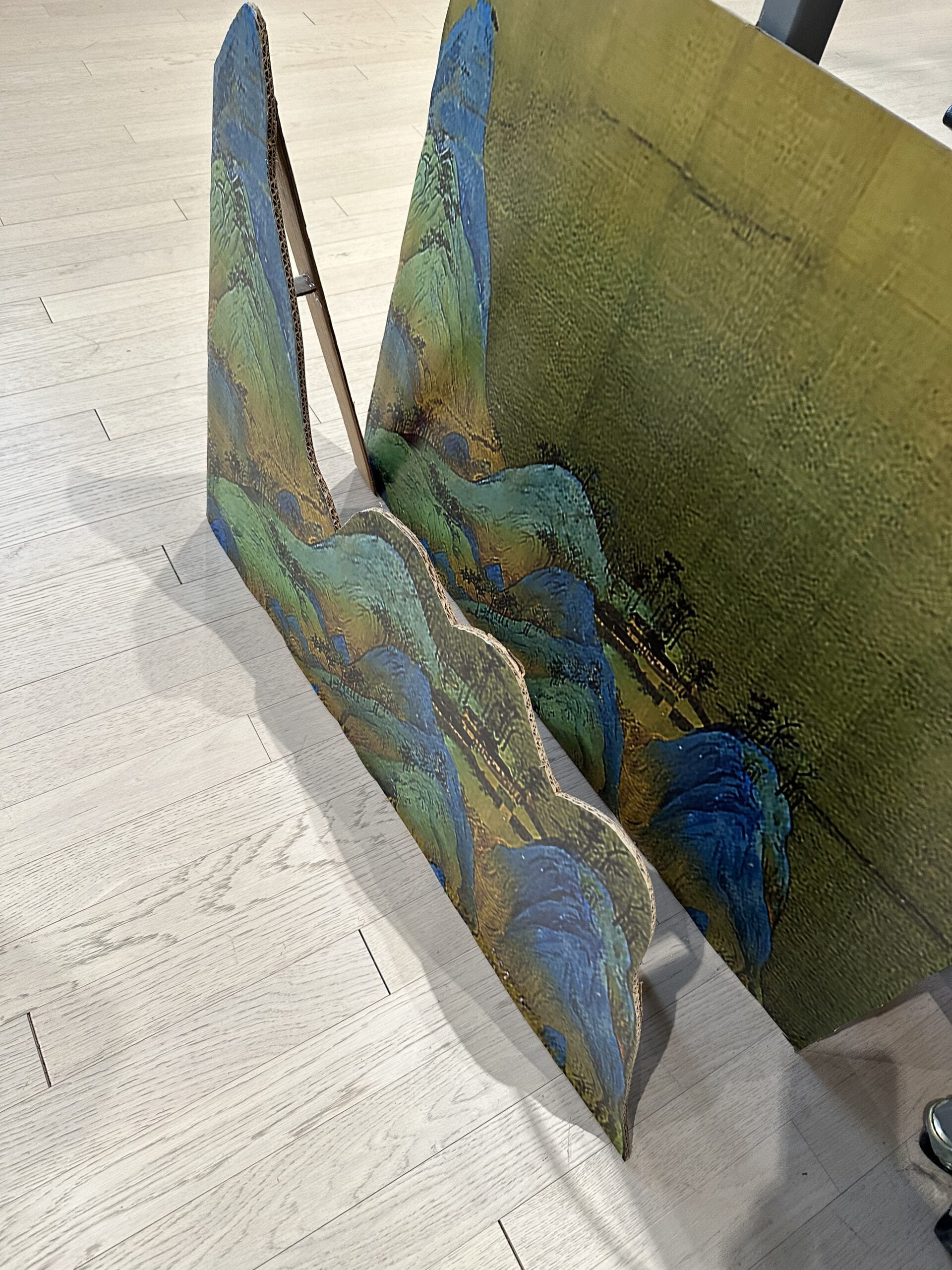
Step2:
To create the water flow, I threaded the fabrics together and cooperated with Livvy to paste it on the servo motor, since she had already attached the servo motors to the back of our layout. However, after we assembled the circuit and powered it, we found that the movement of ‘water’ was not obvious, so we attached some sticks to the servo motors, then the problem was solved.
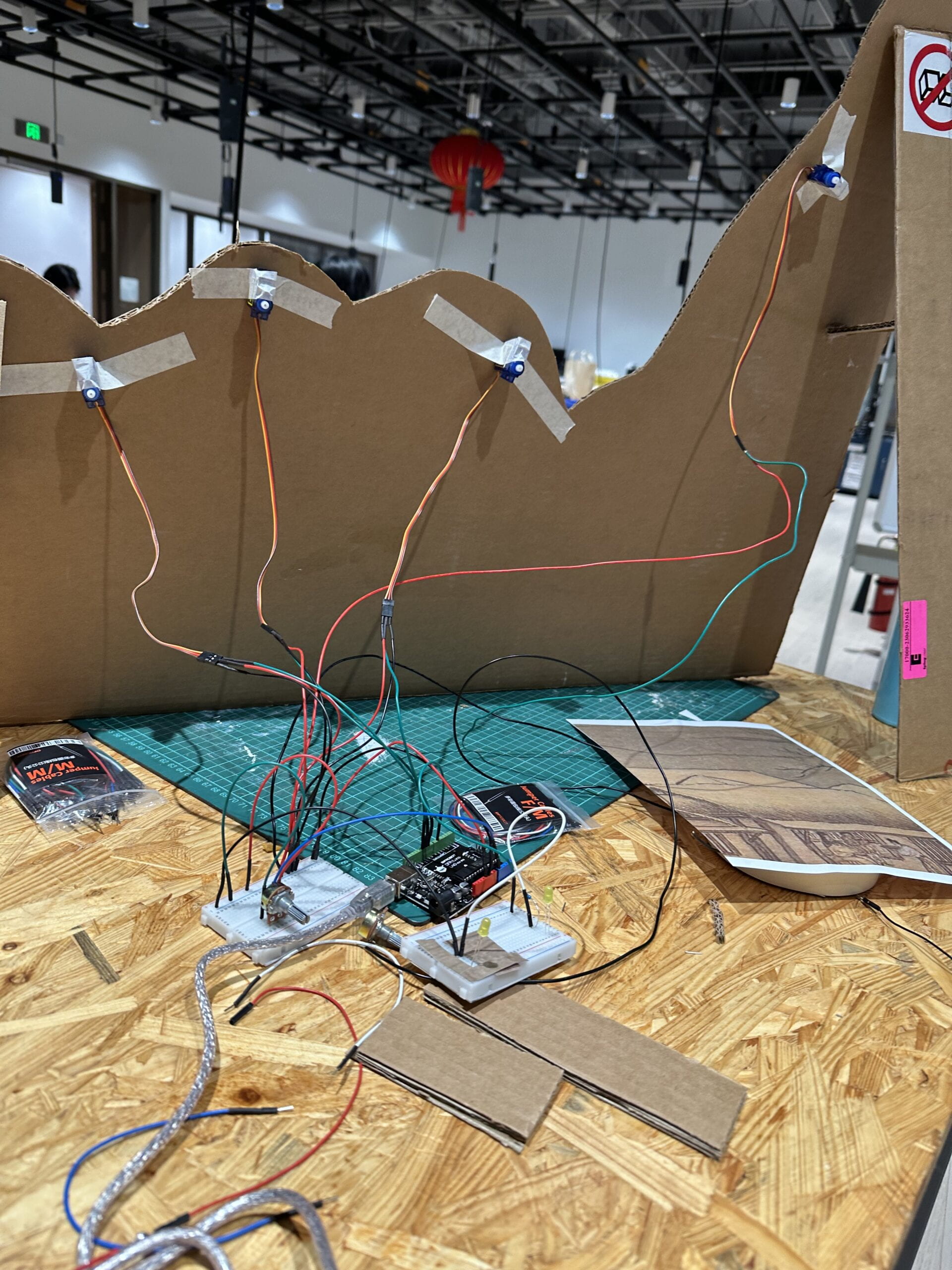
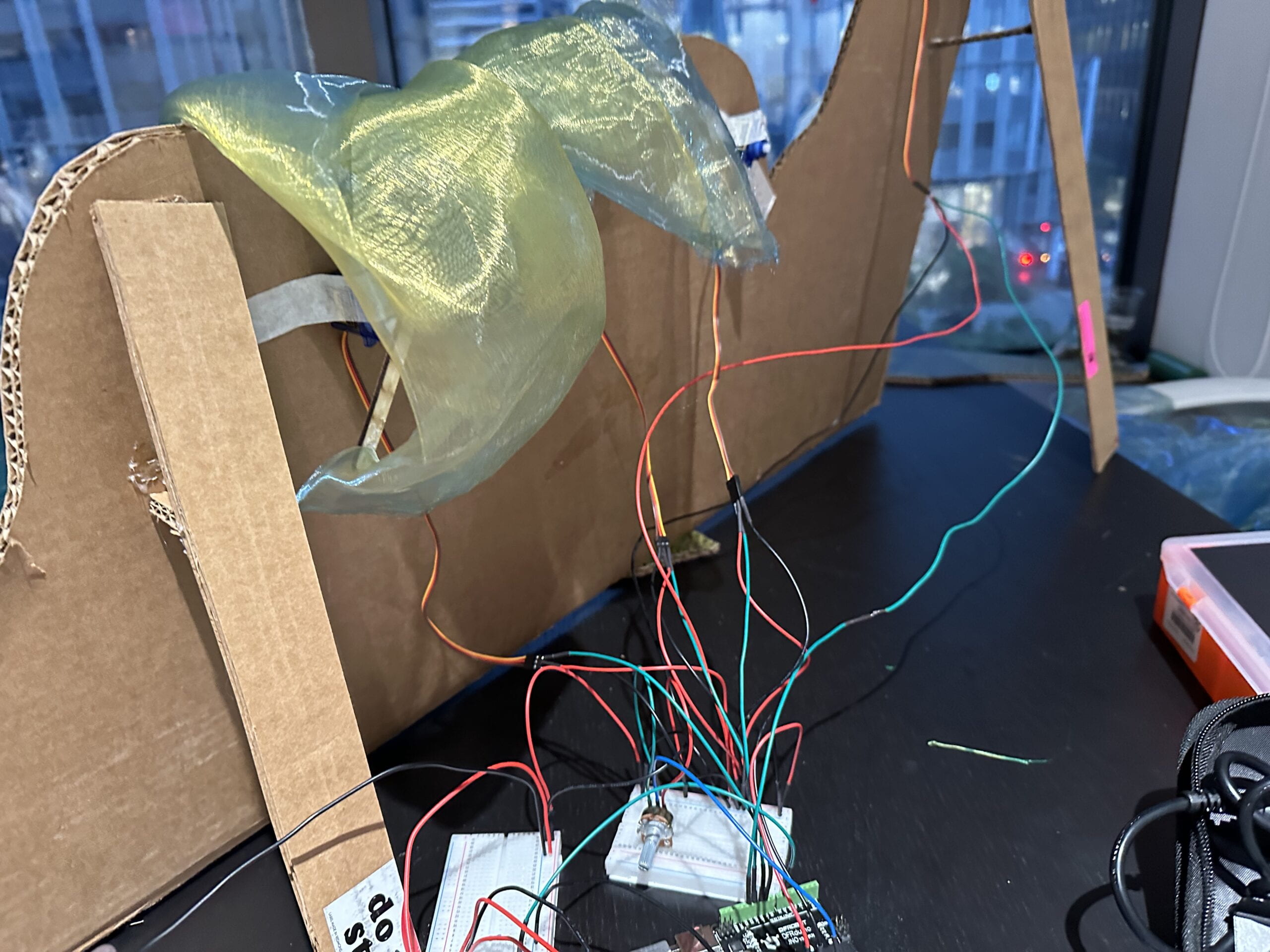
the circuit testing
Step3:
I started to build the little house. In this step, Livvy searched for some ancient Chinese building’s pictures to decorate the little house and I took on the task of building the house’s prototype, namely its main structure. I cut out the cardboard after measuring the proper size of the house’s walls in light of the house in the background painting and cut out two windows for the LED. Then, Livvy pasted the LEDs inside the house. Then, I chiseled a hole for the potentiometer’s knob and covered it with a lid, for users to control the LED and the ‘sun”s brightness. However, after we examined its effect with Professor Inmi, we found that if LED didn’t show up in the window, it wouldn’t be bright enough for the audience to notice. Inmi suggested us put the LED in the middle of the windows and decorate them. So, Livvy borrowed some xuan paper from her friends and decorated the windows. It became much brighter. In addition to the house, we wanted the LED’s light to mimic the sunlight, but we found that it was to dim. So, we turned to Professor Gottfried for help, he advised us to swap LED to 3W High-Power Keyes LED Module with PCB Chassis for Arduino STM32 AVR, which was much brighter.
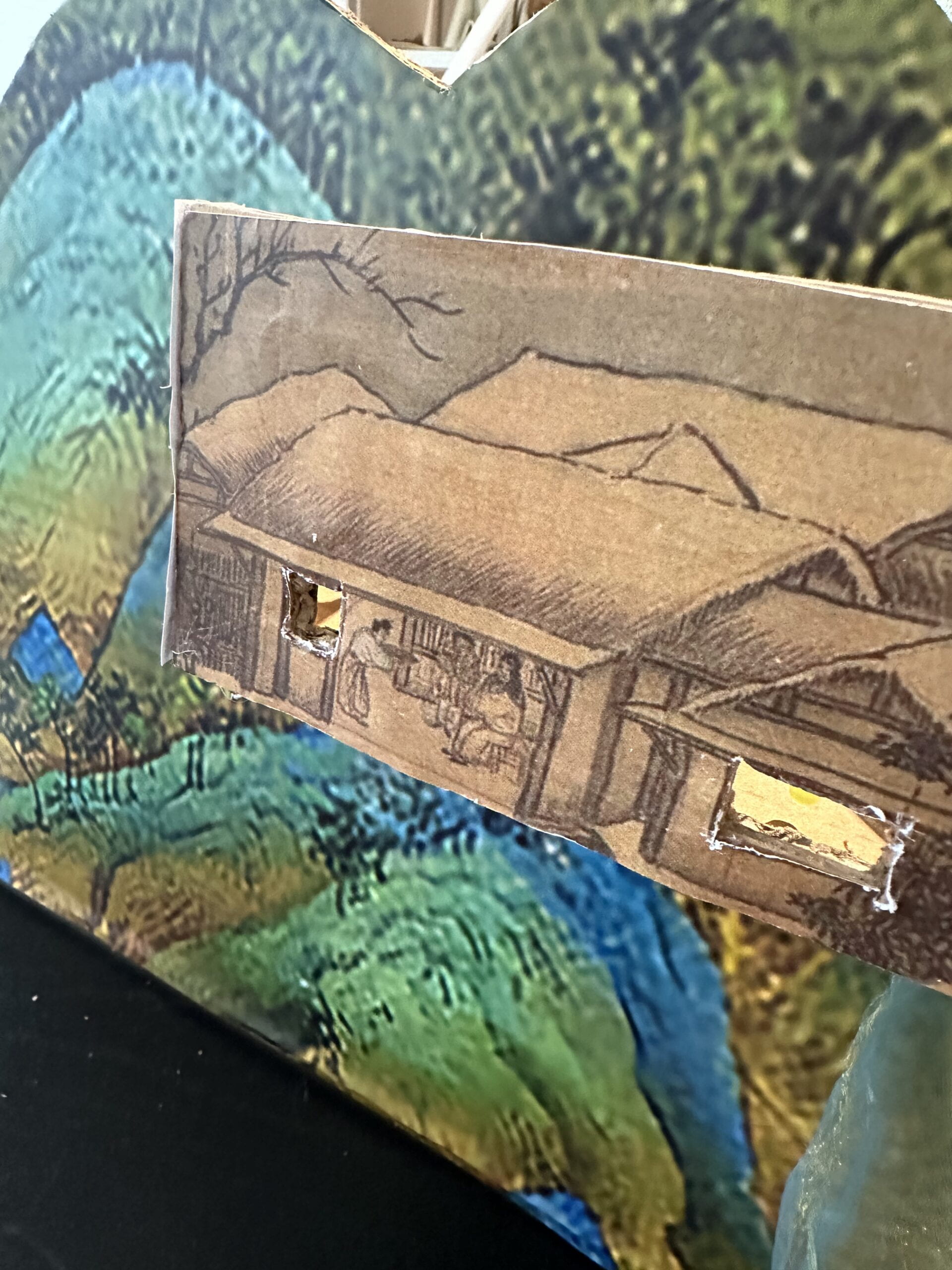
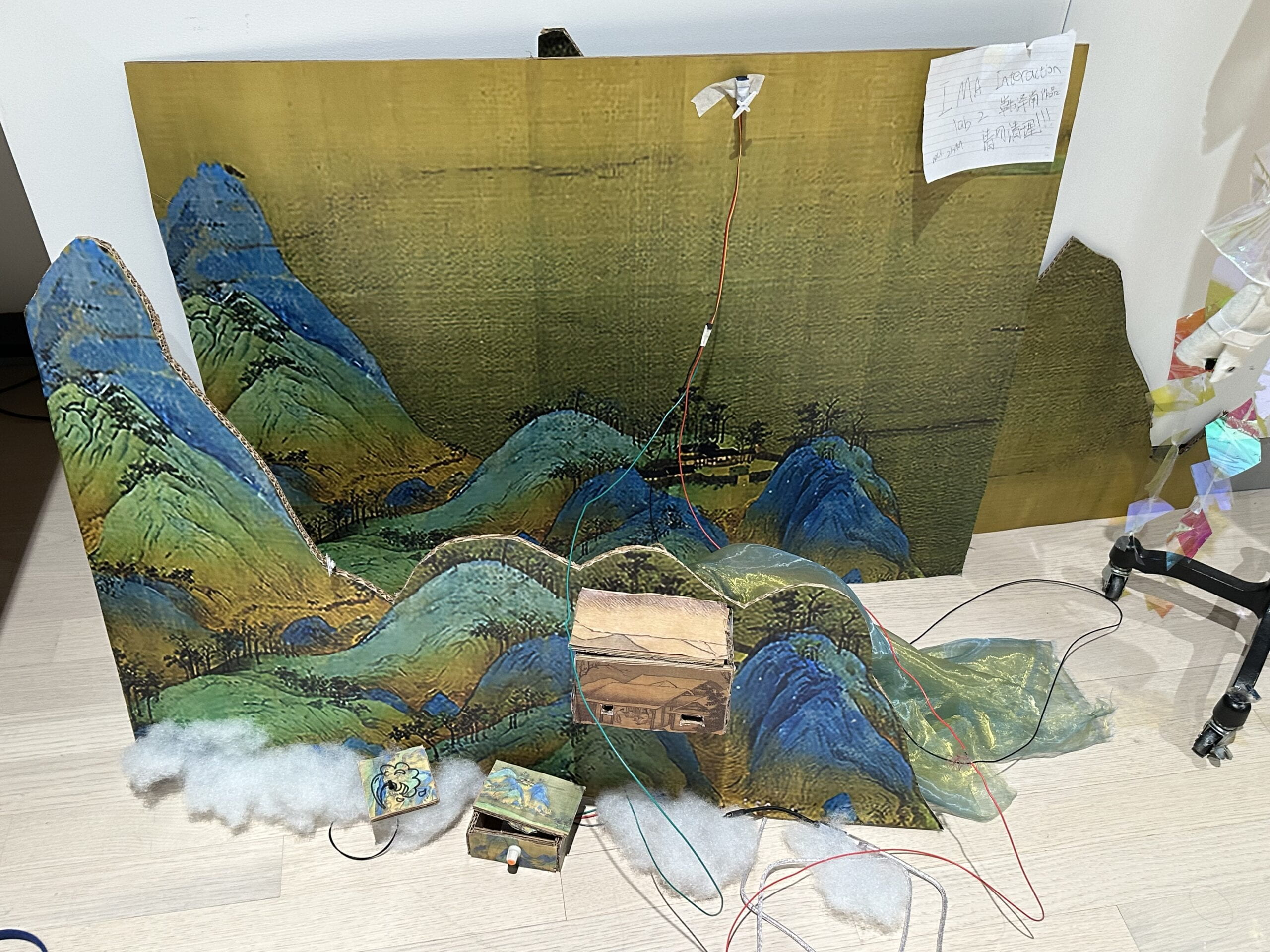
the project with the “sun”
Step4:
Based on Livvy’s idea, we had to use a magnet sensor as the controller of water flow and the boat’s movement. I chiseled a hole on the layout and then, let the sensor thread through the hole and used some cotton to decorate. I also made the controller, which has a magnet on it. However, I found that we needed a hint to guide the audience to realize they needed to put the magnet controller on the sensor. Livvy came up with the idea that she could find some traditional Chinese patterns of the wind and utilize them as decorations, indicating that the controller could let the water flow and the boat move. We did that and I pasted them separately on the controller and the sensor.
the original magnet design
Step5:
This step is much simpler. I made a little boat in the Chinese version and combined it with a cardboard roulette wheel made by cardboard. And we attached the mold of the steppermotor to the wheel, and inserted it in the steppermotor, letting the boat move back and forth with its rotation. Then, we checked our code and tested the whole project’s operation finally. Things went wrong. All the lights didn’t show up. Livvy checked the code again and I inspected the circuit immediately but found nothing wrong. Then we turned to Professor Andy for help. After his inspection, he found that some parts of the wires that we had soldered weren’t isolated from each other. Consequently, we isolated them and everything went well.
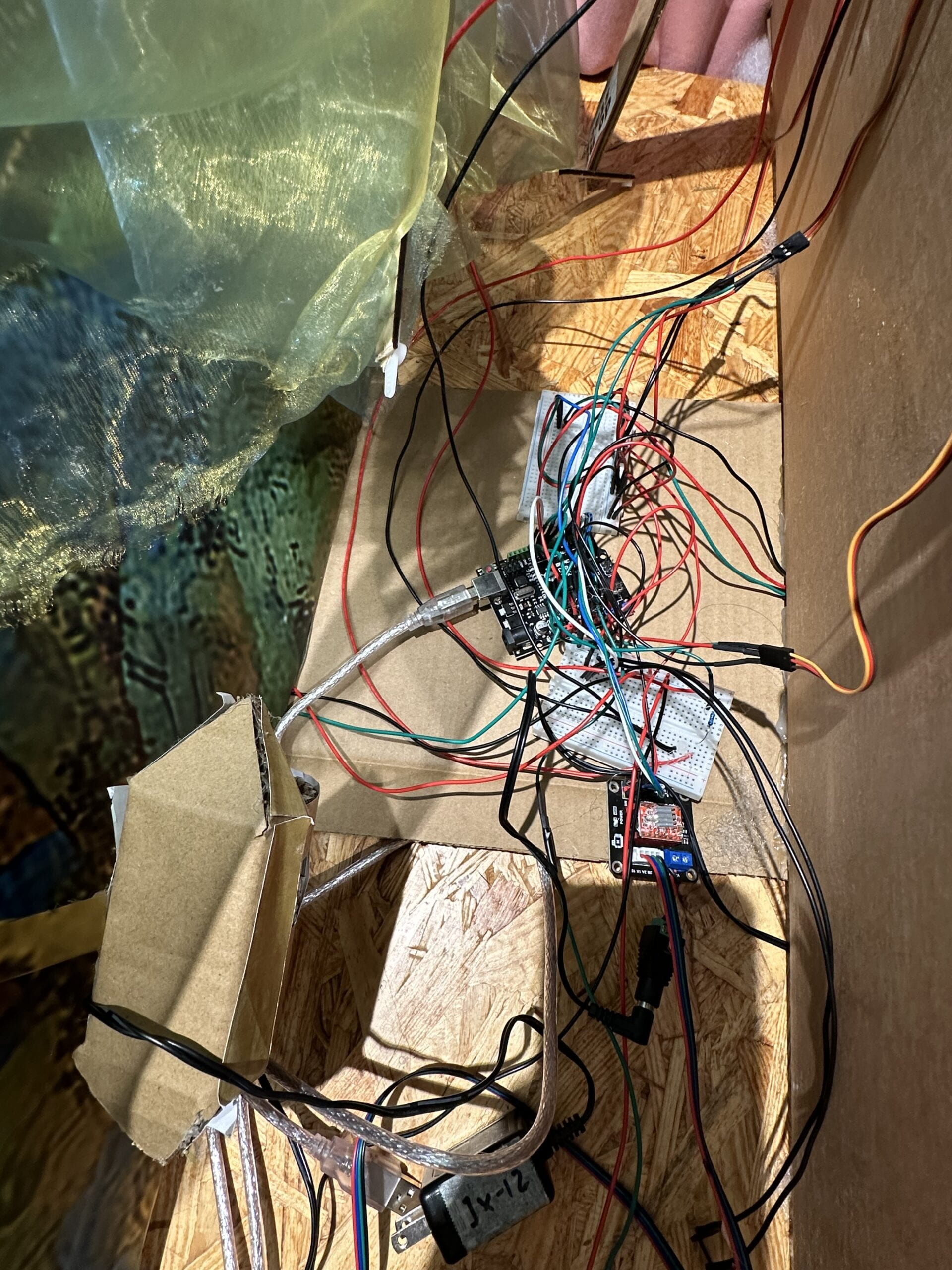
the problematic test before the user test
The User Test:
In the user test, we came across some problems. The first one was that the steppermotor was inevitably heating itself, resulting in melting the mold; the second was that loads of testers failed to recognize the magnet sensor. We also got some precious feedback from them:
My invited tester and Danel: there could be more meaning behind the movement or changes. For instance, when the sun comes out, boat moves forward and when it comes down, boat moves back, meaning the person goes out for fishing in the morning and comes back at night. They also thought the movement could be more complex instead of just moving back and forth.
Kevin: We should hide the servo motor behind the cardboard and cover the wires with some pieces of cotton. The boat’s movement should also be more stable, and it could swing on the ‘water’.
The other people and Professor Inmi thought that the hint of the magnet sensor and the potentiometer’s knob should be more evident and easily understood and perceived.
Based on that valuable feedback, I and Livvy started a discussion. We both thought that since the time was really limited, so it was not applicable to create a whole new mode of boat movement. What we could adjust were, covering the wires with cotton, adjusting the code to make the steppermotor move more smoothly, connecting the fabrics with another one, making the boat swing on the ‘water’, cutting out a circle that was the same size on the controller; and using the printed same ‘wind’ pattern as hints. As for the knob, Livvy suggested printing out some signs of the sun and the moon and some rotating arrows, indicating the knob rotation could control the alteration of day and night. And basically, I modified the controller, decorated the wires, and connected the fabrics. Livvy modified the code. At last, we exchanged a new mold before the presentation. They are really effective except for the magnet sensor.
the presentation recording
conclusions
Our goal of this project is utilizing the ‘low’ movement of nature to form a huge contrast with our ‘fast-paced’ life, evoking the audience’s reflection of the current life and exploring other meanings of life so as to achieve our purpose—let the audiences reflect on their lives inspired by the ‘alive painting of nature and low life style”. Based on our definition of “interaction”, which is the exchange and tackling of information and signals sent from different, multiple actors, happening spontaneously and giving actors enough autonomy to elicit their evaluation or reflection on the information exchange that just happened in order to achieve the designer’s purpose. In the midterm presentation, the tester successfully received and tackled the information from the project, including the hint of rotating the knob and finding the lights on and off, which mimicked day and night but failed to receive some pieces of information such as the hint of the magnet sensor as well as reflect or reevaluate. She just got a sense of the beauty of nature and our project is interesting.
In the midterm presentation, all the things went well except for the hints of the magnet sensor. It was still difficult for the audience to recognize that. But I think we’ve done our best to find the balance between aesthetics and discoverability. For our audience’s feedback, we successfully achieved our intention of letting them enjoy a moment of relaxation and appreciate the beauty of our mother nature. Some of the audiences were really into our boats’ movements, water flow, and the day-night mimicking as well. However, due to a lack of explanation, none of the audience linked this project with a fast or slow-paced lifestyle.
If we had more time, we would first, modify the boats movement, probably use actuators to do so, and hang the controller just next to the magnet sensor and write “pick me up” on it. And probably create a series of movements, with a background story threading those movements, including boats, water, and lights.
We learned that we couldn’t make assumptions about our audiences, we had to make enough hints for me to interact in our designed way in some cases. And every designer has to find the balance between aesthetics and discoverability. In this event, due to our clear division of labor, the problems and challenges were resolved relatively smoothly, which also made me realize the importance of team division of labor and teamwork. Thanks for Livvy’s hard work!
Disassembly

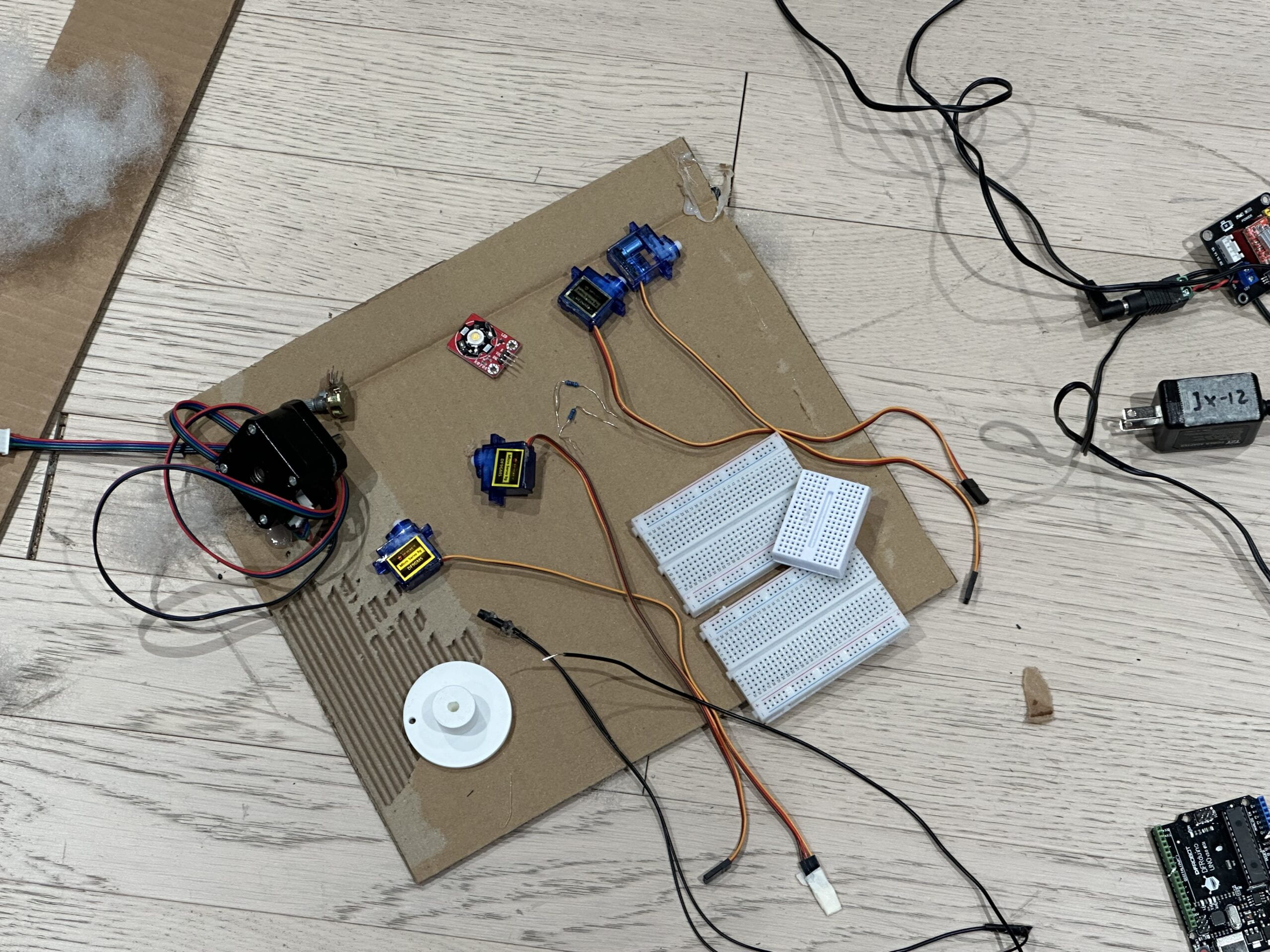
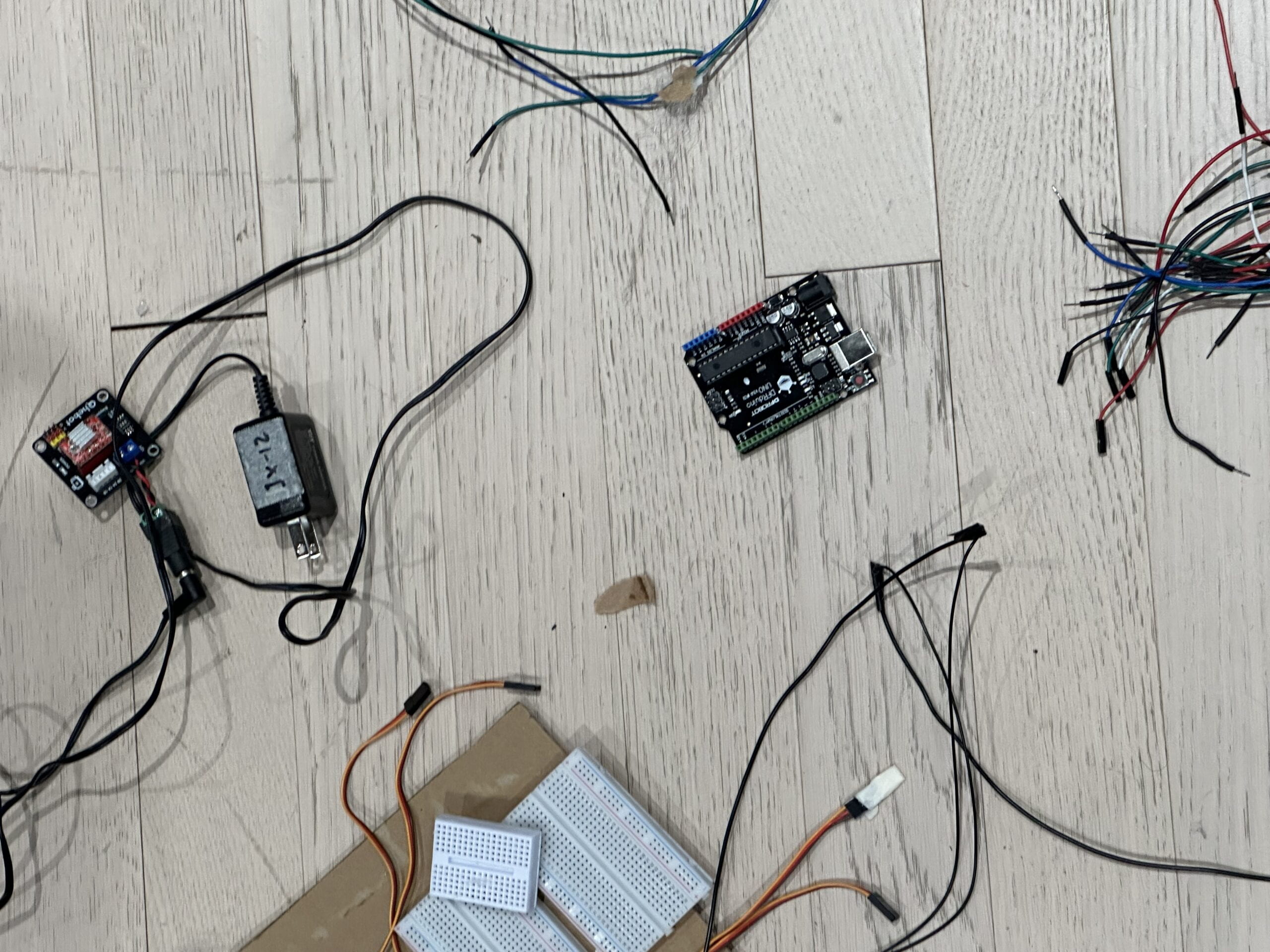
disassembly
Appendix
Wang, Ximeng “A Thousand Miles of Mountains And Rivers”
https://www.comuseum.com/product/wang-ximeng-one-thousand-li-of-rivers-and-mountains/. Accessed 27 Feb. 2024.
Chinese Paintings Department. “Apophrades of Genius: The Ascent of Zhang Daqian’s
Landscape after Wang Ximeng.” Sotheby’s, May 10, 2022,
https://www.sothebys.com/en/articles/apophrades-of-genius-the-ascent-of-zhang-daqians-landscape-after-wang-ximeng. Accessed 27 Feb. 2024.
Ma, Yurong. “Study on ‘A Thousand Li of Rivers and Mountains’ by Wang Ximeng.” The 6th
International Conference on Arts, Design and Contemporary Education (ICADCE 2020).

Atlantis Press, 2021. Accessed 27 Feb. 2024.